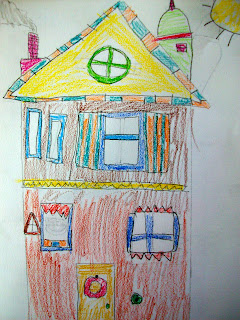



(original lesson found here at deep space sparkle)
Objective: Discuss and define architecture, learn a bit about elements of Victorian Architecture through looking at pictures of San Francisco's Victorian "Pink Ladies" Rowhouses, and create a pen and ink architectural drawing using basic geometric templates.
Supplies: Paper, Pencils & Erasers, Sharpie Fine Tip pens, geometric cardboard templates (IN ART CABINET), Pink Ladies Slideshow
Lesson:
What is architecture?
Architecture is the designing and building of structures, which is a combination of science and art.
Every building that you enter into has been designed by an architect. What kind of things do you think an architect must think about before designing a building? (Ideas may include what a building is for, how the shape of it will help people use it effectively, how the way the building looks fits into the the buildings or landscape). Ask the kids to think for a minute about the buildings they regularly use (home, school, church, stores). Are there features of these buildings that make them attractive? Especially useful? Why do you think our school has a blue corrugated steel roof? (I don't know, btw, but am sure there is a reason!)
Begin slideshow. These are the "Painted Ladies" Victorian Rowhouses, in San Francisco. They are designed in a style of architecture that is known as Victorian, because that is how many buildings in England were built during the reign of Queen Victoria (1839 - 1901) and the popularity of the style caused architects all over the world to imitate it. There was an explosion of people who wanted to live in San Francisco from 1850 - 1901, and during that time there were around 50,000 Victorian homes built in the city. Unfortunately many of them were destroyed during the big 1906 earthquake and fire, but if you drive around the city in the Upper Haight, Fillmore, and Pacific Heights neighborhoods you can still see some really pretty examples.
Scroll through slides, and discuss some of the following information:
You can tell Victorian architecture because the following elements are often included in the design: turrets (those fancy little towers), large windows (some of them are paned with stained glass), decorative brackets, arches and curves, balconies, bright paint colors, and lots of trim.
Ask the students to point out some of these features in the pictures you show.
Additional points of discussion may include:
What do houses like this make you think about the person who designed them?
What were the designers of these homes trying to say?
Activity:
Have the students use the large rectangular cardboard templates to draw basic shapes for their own Victorian creation. Once they have maybe two or three tall rectangles drawn, have them add other elements using the other templates: windows, doors, roofs, etc. After they have the core of their drawing done, pass out the sharpies and have them trace over their pencil drawings. Then they can put aside the templates and add their own fanciful details using their imaginations: turrets, shingles, scrollwork, etc. If time allows, they can add color with markers.
(Practical tip: once the basic shapes for the drawing are down and traced in sharpie - i.e., the rectangle building shapes, make the kids put their pencils away and use just the sharpies for the remainder of the drawing. If they draw the entire picture in pencil and then try and trace it, it will take them forever and they will not finish in one lesson.)

No comments:
Post a Comment